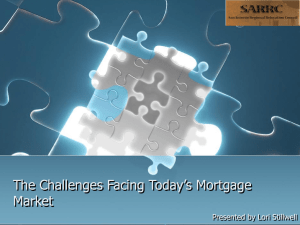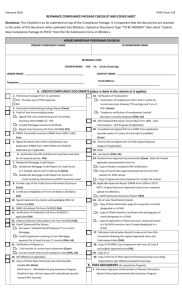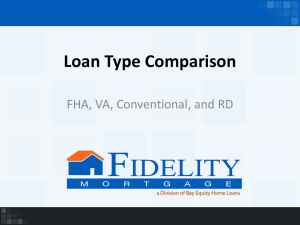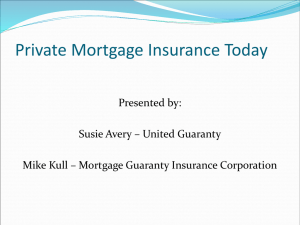MAP Training - smaconline.net
advertisement
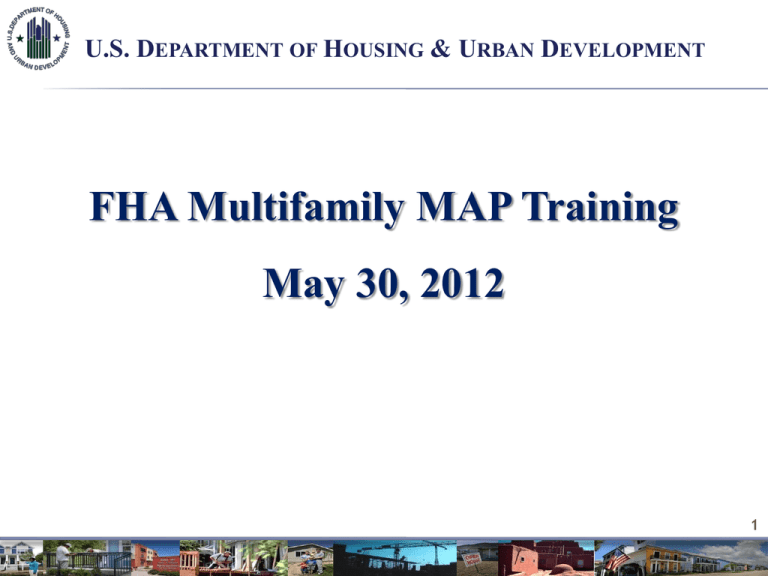
U.S. DEPARTMENT OF HOUSING & URBAN DEVELOPMENT FHA Multifamily MAP Training May 30, 2012 1 U.S. DEPARTMENT OF HOUSING & URBAN DEVELOPMENT AGENDA –morning 8:45-9:15am … Pre-test. Introduction, overview of agenda and training objectives. 9:15 -10:00am …Processing/MF FHA 101 10-10:15am … Break 10:15am-12:15pm … Case study 12:15 pm – 1:30pm… Lunch 2 U.S. DEPARTMENT OF HOUSING & URBAN DEVELOPMENT AGENDA –afternoon 1:30-3:15pm … Case study 3:15-3:30pm … Break 3:30-4:45pm … Post-training Exam 3 U.S. DEPARTMENT OF HOUSING & URBAN DEVELOPMENT MF FHA 101 • Basics of FHA financing • Overview of Processing 4 MF DEVELOPMENT – OUR MISSION • BUILD COMMUNITIES • SUPPORT AFFORDABLE HOUSING • PROVIDE LIQUIDITY to CAPITAL MARKETS U.S. DEPARTMENT OF HOUSING & URBAN DEVELOPMENT History • 2000-present MAP 6 MULTIFAMILY INSURED LOAN ENDORSEMENTS OVER THE LAST TEN YEARS $12.0 $10.0 $8.0 $6.0 $4.0 $2.0 $0.0 2000 2001 2002 2003 2004 2005 2006 Includes risk share and basis FHA loans. Source: Multfifamily Housing. 2007 2008 2009 2010 2011 Endorsements in billions of dollars $14.0 PORTFOLIO OF FHA-INSURED MULTIFAMILY APARTMENTS, BY PROPERTY TYPE Total Insured Portfolio: 931,000 apartments as of November 29, 2010 Insured only 456,084 49% Insured - Subsidized 20,148 2% Insured - Assisted Subsidized 138,273 15% Insured - Assisted 316,736 34% Source: HUD databases MULTIFAMILY LOAN PORTFOLIO BY LOAN VALUE Total Insured Portfolio: $43-Billion as of November 29, 2010 Insured only $30,947,000,000 72% Insured - Subsidized $85,000,000 0% Insured - Assisted Subsidized $1,211,000,000 3% Source: HUD databases Insured - Assisted $10,815,000,000 25% FHA PROGRAM BASICS • MAP (Multifamily Accelerated Processing): NC/Sub Rehab, Refinance/Acquisition, Supplemental Loans for Apartments TAP (Traditional Application Processing): for Other including co-ops, mobile home parks, lender identity of interest __________________________________________ • LEAN/Health Care: Assisted Living, Board & Care, Nursing Homes, Hospitals • FHA PROGRAM BASICS New Construction / Substantial Rehab: • • Sections 220 for Mixed Use, 221(d)(4), 231 for Elderly, 241(a) Improvements/Additions Section 221(d)(3) -- to be suspended in FY13 Two stages of processing: • • Pre-application Firm FHA PROGRAM BASICS Refinance / Acquisition of Existing Properties: • Sections 223(a)(7) for already FHA-insured, 223(f) One stage processing only: • No Pre-application FHA PROGRAM BASICS What about elderly, age-restricted housing? • 221(d)(4) & 223f: May restrict Head of Households (HOH) to 62+; cannot exclude children • 231: All residents must be 62+ and/or disabled • No FHA MF program may restrict HOH or residents to 55+ (otherwise OK under Fair Housing’s “Hsg for Older Persons Act”) ADVANTAGES OF FHA FINANCING • • • • • • Permanent, fixed rate, long term, fully amortizing Construction/permanent loan combined Useable in “C” Markets Can be combined with other resources, e.g., Section 8, LIHTC (note: new “Tax Credit Pilot”) High Leverage, especially with Builder’s/Sponsor’s Profit & Risk Allowance (BSPRA) for NC/SR (note: new Risk Mitigation standards, especially for Large Loans) Non-Recourse (note: Regulatory Agreement #50 provision for “bad boy carve-out”) DISADVANTAGES OF FHA FINANCING • With increased volume, long processing times (e.g. between 88 and 1,178 days from engagement letter to closing on transactions closed in the last few years by a typical lender) • With increased volume and Risk Mitigation, uncertainty about results on deals and relationships with HUD Offices • About 60 - 75% NC/SR, 85 - 90% existing property deals are approved; National Loan Committee is approving 90% DISADVANTAGES OF FHA FINANCING • • • Mortgage Insurance Premium (MIP) Note increases proposed for FY13 Firm Commitments: NC/SR: from .50% to .70% a7’s: from .45% to .50% 223f’s, all others: .45% to .60% No increase if with LIHTC or Project Based Section 8 Audited Annual Financial Statements, REAC inspections, possibility of enforcement, semi-annual HUD approval to pull $ out, R4R Potentially more restrictive repair requirements (e.g. smoke detectors, Fair Housing and Accessibility requirements) OVERVIEW OF PROCESSING – WHO’S WHO Borrower: What/who are they dealing with? • Existing debt, partners, the IRS, lenders, the project • Single asset mortgagor, management agents, tenants Your friendly lender: • Correspondents, originators, [underwriters], construction loan admin, servicing • Marketing, advertising, borrower contacts, structuring/ slotting, pre-screening, engagement Overview of Processing – Who’s Who Your Friendly Local HUD Office: What they are doing . . . • Screening, publishing queue listing • Cashing check (soon to be pay.gov) or sending a letter • HUD Technical Review Programs Valuation EMAS Labor Relations • A&E Env. Legal Loan Approval – Issuing a Firm Cost Asset Mgt FHEO Mortgage Credit WHAT WE DO IN UNDERWRITING: QUESTIONS WE ASK: • • • • • • • Will they pay us back? Will enough people live here? When will they do so? How much will they pay for doing so? Will HUD approve it? Given specific program requirements -- e.g., 223f repair limits, Remaining Economic Life, DSCR/LTV’s, commercial income standards, environmental requirements -- will it “pencil out?” Borrower, lender: Can we make money at this? DETERMINING INSURABLE MORTGAGE AMOUNT: VALUE, DEBT SERVICE COVERAGE, COST • Net Operating Income (NOI) = “Rental Income” less “Expenses.” So what to consider in determining these? See 2264 Section F. • “Rental Income” = Estimated total potential “project income” + estimated “ancillary project income” X residential occupancy % = “Effective Gross Income” (EGI) Subtract total residential & ancillary project expenses = “Net Residential Rental Income” If commercial income involved, factor it in also, same approach with total potential commercial income X commercial occupancy %, less commercial expenses. = “Net Commercial Income” • • “Net Residential” + “Net Commercial” = NOI DETERMINING INSURABLE MORTGAGE AMOUNT: VALUE, DEBT SERVICE COVERAGE, COST • Value = Net Operating Income Cap Rate • Example: NOI = $678,500_____ Cap Rate = 6.75% or .0675 = $10,051,851 If 223(f) market rate, mortgage cannot exceed 83.3% of value. So: $10,051,851 X 83.3% (or .833) = $8,373,100 max. ins. Loan • Value = “Criterion 3” on HUD- 92264A DETERMINING INSURABLE MORTGAGE AMOUNT: VALUE, DEBT SERVICE COVERAGE, COST • DSC mortgage = Net Operating Income X Program Limit (Interest rate + MIP + “Initial Curtail Rate”) • Example: NOI = $678,500 X 83.3% (4.5% + .45%MIP + 1.5802% Initial Curtail) = NOI = $678,500 X .833 (.045 + .0045 + .015802 Initial Curtail) = $8,655,000 • Debt Service = “Criterion 5” on HUD- 92264A DETERMINING INSURABLE MORTGAGE AMOUNT: VALUE, DEBT SERVICE COVERAGE, COST • Cost-limited mortgage = Mortgageable Costs X Program Limit • Mortgageable Costs = Fixed Costs + Variable Costs (e.g., fees) • Example: It costs $100 in fixed costs to build a project and 8% of the total costs are variable costs. The mortgage amount is 90% of the total costs. How much is the mortgage? MORE ARITHMETIC – BASIC ALGORITHM FOR THE REPLACEMENT COST FORMULA WORKSHEET Total Cost = $100 (Fixed) + 8% (variable) of Total Cost TC – 8%TC = $100 92%TC = $100 TC = $100 .92 = $108.69 Mortgage = 90% of TC = $97.82 Replacement Cost = “Criterion 3” on 2264-A “Lowest of” criteria = controlling mortgage amount • SOME OTHER IMPORTANT PROGRAM REQUIREMENTS THAT MAY IMPACT UNDERWRITING • Davis-Bacon for NC/SR “Statutory Limits” = “Criterion 4” on 2264-A • Section 223f repair costs less than $6500/unit X HCP (new policy under review) • Commercial limits by Program and Net Rentable Area, EGI • • More conservative DSC/LTV for Large Loans >$40M • Reserve for Replacement $ determined by PCNA • Current MAP Guide, e.g. Chapter 9 Environmental 25 After the Firm Commitment is issued BACK TO THE LENDER • • • • • • • Borrower Acceptance Good Faith Deposit Rate Lock Prep Closing Docs Submit Closing Docs, HUD reviews, ENDORSEMENT!! Construction Loan Administration Transition to Asset Management COMING POLICIES (TO BE DISCUSSED ON TUESDAY) • Underwriting (a)7’s • PCNA/R4R requirements • MAP Guide Revision 2 • Rental Assistance Demonstration (RAD) lending • Lender/underwriter tiering regulation 27 1ST CASE STUDY: 10:15AM-12:15PM 1. Get in teams, introduce each other, and ensure team is familiar with case 2.“A” Team presents the loan, focusing on strengths and weakness, and issues they analyzed; “B” Loan Committee Team asks questions 3. Loan Committee deliberates (apart from “A” team), votes, briefly writes up decision (approve, approve with conditions, or disapprove), hands written decision to a monitor 4. All teams/groups reconvene in main conference room; leaders of “B” teams acting as loan committees will be prepared to state reasons for their team’s decision 5. HUD Trainer moderates further discussion, conducts summary presentation 6. Final questions from participants 2 8
